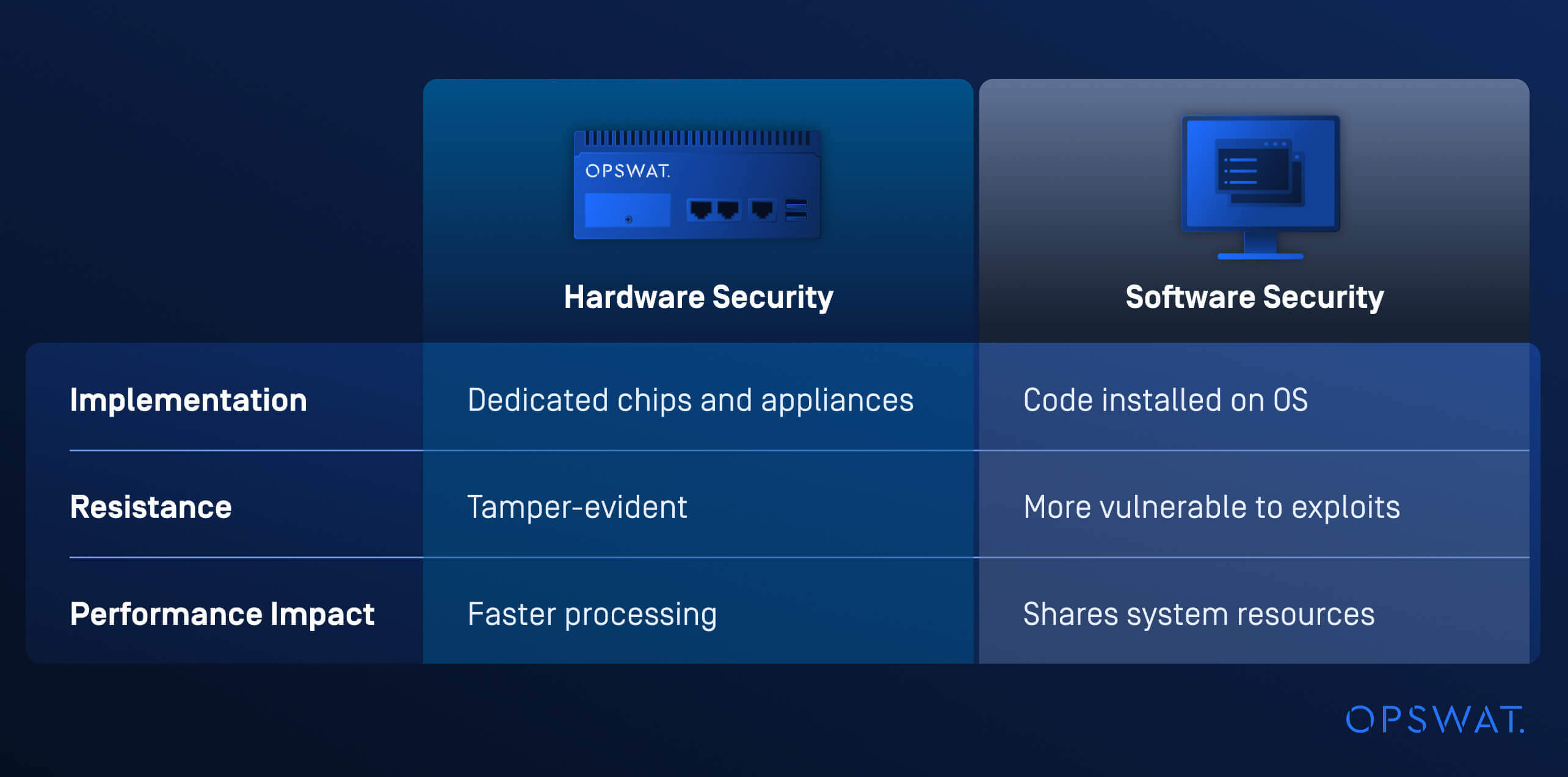Cybersecurity hardware refers to physical devices specifically engineered to protect systems from malicious activity, both on-premises and internet-connected. Unlike software-based solutions, hardware security provides tamper-resistant protection, including encryption, authentication, and threat inspection at the physical layer.
- What is Cybersecurity Hardware?
- Core Types of Cybersecurity Hardware
- Key Security Functions and Capabilities
- Deployment, Integration, and Management
- Threats, Vulnerabilities, and Attack Vectors
- Standards, Protocols, and Compliance for Hardware Security
- Specialized and Emerging Areas in Cybersecurity Hardware
- Benefits and Limitations of Cybersecurity Hardware
- Protecting Peripheral and Portable Media Threats
- FAQs
What is Cybersecurity Hardware?
Cybersecurity hardware appliances and physical modules incorporate methods like enforcing encryption, authentication, and intrusion detection to defend digital workflows and physical infrastructure against attempted cyberattacks. The scope of their protection spans from perimeter firewalls to in-chip secure elements.
Hardware vs. Software Security: Key Differences
While software security focuses on controlling applications and systems through code, hardware security integrates protection directly into physical devices. Both approaches need to be implemented simultaneously to defend against modern, complex cyberattacks and to create multi-layered defense strategies.

Core Types of Cybersecurity Hardware
There are three primary cybersecurity hardware categories used across enterprises to protect networks and endpoints:
Network Security Appliances
Network security includes perimeter devices inspecting network incoming and outgoing traffic, such as firewalls and UTM (Unified Threat Management) platforms. Such devices are commonly deployed to inspect and block malware hidden in encrypted traffic.
Endpoint Security Hardware
This includes physical devices attached to endpoint hardware, such as laptops, desktops, and mobile units. The purpose is to enforce authentication and lockdown, including security tokens, smart cards, and biometric scanners.
Specialized Security Modules
Cybersecurity hardware can be created for specific cases, such as HSMs (Hardware Security Modules), which are dedicated to key generation, storage, and cryptographic operations. IDS (Intrusion Detection System) and IPS (Intrusion Prevention System) appliances also play a crucial role in network security. The first monitors and analyzes network activities for signs of unauthorized access, and the latter detects and blocks malicious activities in real-time.
Key Security Functions and Capabilities
A major advantage of hardware security devices is that they include network protection capabilities that software solutions alone cannot match.
Encryption, Authentication, and Access Control
Hardware-based encryption offloads CPU-intensive cryptography to dedicated hardware. Authentication also benefits from hardware integration with tools like biometric modules and secure elements to enforce multi-factor checks.
Threat Detection and Prevention
Packet Inspection via hardware helps with faster examination of network traffic for anomalies, malware signatures, and policy violations. Also, features like secure boot ensure that devices only run trusted firmware, reducing the risk of rootkits and persistent malware.
Deployment, Integration, and Management
Deployment Models
Differences in environmental and operational requirements across industries result in varying cybersecurity hardware deployment models:
- On-Premises: Such as physical racks in data centers
- Edge: Smaller devices deployed close to the end user
- Cloud/Hybrid: Virtual HSMs or cloud-managed devices
Management, Monitoring, and Updates
Cybersecurity hardware must be continuously managed to remain effective:
- Device Management: Using centralized consoles for configuration and user provisioning
- Firmware Updates: Scheduling regular patching to minimize downtime
- Monitoring & Alerting: Aggregating logs from hardware consoles
Threats, Vulnerabilities, and Attack Vectors
Understanding how attackers target hardware helps craft robust defense-in-depth plans.
Common Hardware Threats
Threat actors often target hardware supply chains to inject malicious components or firmware:
- Physical Tampering: By opening enclosures to inject malicious chips or extract keys
- Supply Chain Attacks: Compromising firmware during manufacturing or shipping stages
- Side-Channel Attacks: With methods like power analysis or electromagnetic snooping
Mitigation Strategies and Best Practices
A combination of hardware design principles and operational best practices plays a significant role in building a multi-layered defense against cyberthreats:
- Rogue Device Detection: By network-level scanning to identify unregistered hardware
- Firmware Security: Enforcing secure boot by digitally signed firmware images
- Incident Response: Establishing procedures that include hardware forensics and replacement protocols
Standards, Protocols, and Compliance for Hardware Security
Hardware security must adhere to a set of industry standards and regulatory requirements.
Security Standards and Certifications
- IPS 140-2/3: U.S. government benchmark for cryptographic modules
- Common Criteria (ISO/IEC 15408): International framework for security evaluation
- PCI DSS & ISO/IEC 27001: Standards for payment and information security
Protocols and Guidelines
- TLS & IPsec: Secure communication protocols
- IEEE 802.1X: Port-based network access control
- NIST SP 800-147 and SP 800-193: Guidance on hardware lifecycle management
Specialized and Emerging Areas in Cybersecurity Hardware
With the emergence of new technologies, novel hardware solutions are required to address new risks:
Embedded Systems and IoT Hardware Security
Embedded devices and IoT systems often operate in untrusted environments with limited processing power. Specialized hardware, such as secure elements and MCUs (microcontroller units) with built-in cryptographic functions, can enhance security.
Physical Layer Security
Physical layer security refers to specific techniques that secure communication channels, such as protecting against signal interception, jamming, and electromagnetic eavesdropping. Physical-layer defenses are becoming increasingly relevant in high-security environments, such as military communications and critical infrastructure.
Benefits and Limitations of Cybersecurity Hardware
Why Hardware Security Matters
Hardware Security enhances the protection of hardware supply chains, helping with tamper resistance and defending against firmware exploits. In addition, it reduces the load on the software security solution, which might suffer from latency and high CPU load while performing tasks, such as cryptography.
Why Software-Based Security Alone Is Not Enough
Despite being essential, software-based security requires continuous maintenance, vulnerability patching, and database updates. It is also easier to overcome than hardware-based security. Employing both software and hardware cybersecurity creates multi-layered security and contributes to building a defense-in-depth strategy.
Protecting Peripheral and Portable Media Threats
Including peripheral and removable media protection is essential for a robust hardware security program. Solutions like MetaDefender Kiosk™ to scan and sanitize removable media, coupled with MetaDefender Media Firewall™ for policy enforcement, and centralized management using My OPSWAT Central Management™ provide integrated security to defend against known and unknown threats, including zero-day exploits.
Rethinking your hardware security strategy to include removable media protection? Get in touch with an expert today to see a demo.
Frequently Asked Questions (FAQs)
Is cybersecurity hardware or software?
Cybersecurity is both. Hardware refers to physical devices designed for security functions, while software solutions are code-based. A robust defense strategy combines both.
What is hardware security?
Hardware security employs specialized appliances, such as removable media protection solutions to sanitize removable media, and HSMs and secure elements to enforce encryption, authentication, and integrity at the hardware level.
Why does hardware security matter?
Hardware security provides tamper resistance, secure storage, and better performance that software alone cannot achieve.
Why are software-based security solutions not enough?
Software is vulnerable to malware, exploits, and patch delays. Hardware provides trusted execution and resistance to manipulation.

